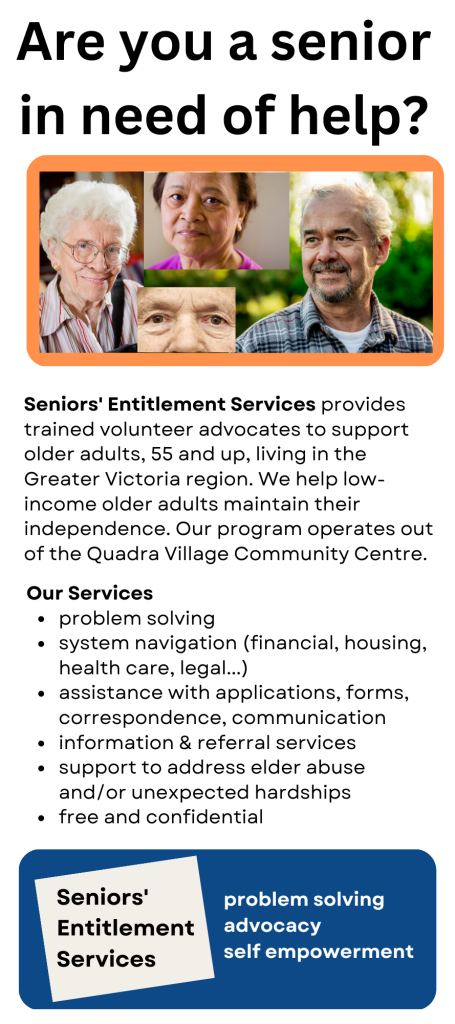Mabel is direct in her communications. Aged 67, of low-income, her tenancy at-risk, and loaded with all sorts of health concerns, Mabel leaves no doubts. She isn’t ready to give up. She wants to maintain her independence for as long as possible. She just needs help doing that.
 Seniors’ Entitlement Services
Seniors’ Entitlement Services
Mabel’s attitude typifies that of the 450 Capital Region seniors served by the Seniors’ Entitlement Services (SES) program over the past year. From 2019-2024, I coordinated the SES program. (I’m leaving the program, passing the baton, this month). This was a part-time job. The program operated out of a community-based nonprofit, Quadra Village Community Centre. The Centre’s tag line is “Heart of the neighbourhood”. So true. So true. The advocacy work of the SES team (myself and 8-10 experienced volunteers) helped many folks such as Mabel move their life forward in a positive way. I’ve discovered that advocacy work has much in common with mediation and conflict resolution. For example: active listening, issues management, proactive and creative problem-solving are valued attributes of both advocate and mediator.
During my tenure with SES, the number of seniors we assisted has almost doubled. While I welcome a pat on the back for helping expand the service, the larger truth is that life has become more difficult for low-income seniors, the demographic we mostly serve. What follows are a few insights and ideas based on my SES experiences.
The trends are troubling.
Widening income gap. The Office of the BC Senior Advocate’s 2022 income-focused research report, BC Seniors: Falling Further Behind, is bang-on from the SES perspective. The income gap between the haves and have-nots continues to widen. The poor are impacted the most. 80-90% of the seniors SES assisted were low-income. Low-income directly impacts rent payment, food supply, health care, home help, legal services, transportation… The list is long.
More complex problems. The challenges faced by low-income seniors are systemic. They are complex. Life isn’t lived in silos. Closing the door on one problem often opens the door to another. Can’t pay the rent? I’ll borrow from my food budget. Food short? I’ll visit the food bank. Mobility issue? I’ll just stay home. A further consequence of helping multi-barrier seniors is that the strain on volunteer advocates helping those seniors becomes magnified.
Poor government communication. It’s a tech world. In the SES program, hardcopy pamphlets and brochures have in-large been ditched for online. Today’s norm is online. That’s also the way government wants it. The pandemic escalated the conversion to online. The word communication has Latin roots. It means to make common, to get on the same page. Government and low-income seniors are not on the same page. SES clients, and (experienced) volunteer advocates, are subject to a snakes and ladders quest to access and make sense of government information. Imagine the user experience the senior not raised online must navigate. (I wrote about this system design dilemma before, here.)
What can we do?
Make it easy to connect. Go to where seniors live. Why should a senior with mobility issues have to travel crosstown to get in-person support? Emphasize place-based service delivery. Community centres, libraries, malls, houses of worship, apartment foyers, you’ll find seniors there and many other places, closer to home. Build on what’s already in-place. Where feasible, establish one-stop support for low-income seniors. The Seniors Advocate recommends Work BC as a model to follow. No space to offer? Maybe bring in a mobile service unit; e.g., dental, legal, counselling, or rotate those services among different locations.
Leverage regional coordination and support. Community-based services rely on volunteers. While volunteer activity and service delivery can/should be local, volunteer training and support can access regional services/capacity. Where I live the, Coalition of Neighbourhood Houses – Capital Region exemplifies a practical framework to implement regional support and coordination. Offer local training and support by way of a connected central hub. This will help avoid duplication of services at the local level and/or lack of local services due to limited local resources. Establish a regional advocacy community-of-practice (Our own SES team operated as a community-of-practice). Collaborate x-organizations. When funding agencies such as United Way reward inter-agency collaboration they do that for good reason.
Collaborate with users on system design. Memo to government: Only the status quo is served when government excludes the end-user from system design. The 30-year-old government analyst is no proxy for the interests of the 75-year-old senior in survival mode. Inclusive design reduces the system designer-user gap. It helps dissipate the communications fog enshrouding many government systems (BC Housing comes to mind). It makes seniors visible.
These strategies interrelate. They are person-centred, community oriented, and necessary. They do not require the mega-dollars as does (much needed) large-scale subsidized rental housing development. They do require our collective mind shift towards better communications with, and support of, seniors on low-income.
Mabel will thank us.


Speak Your Mind